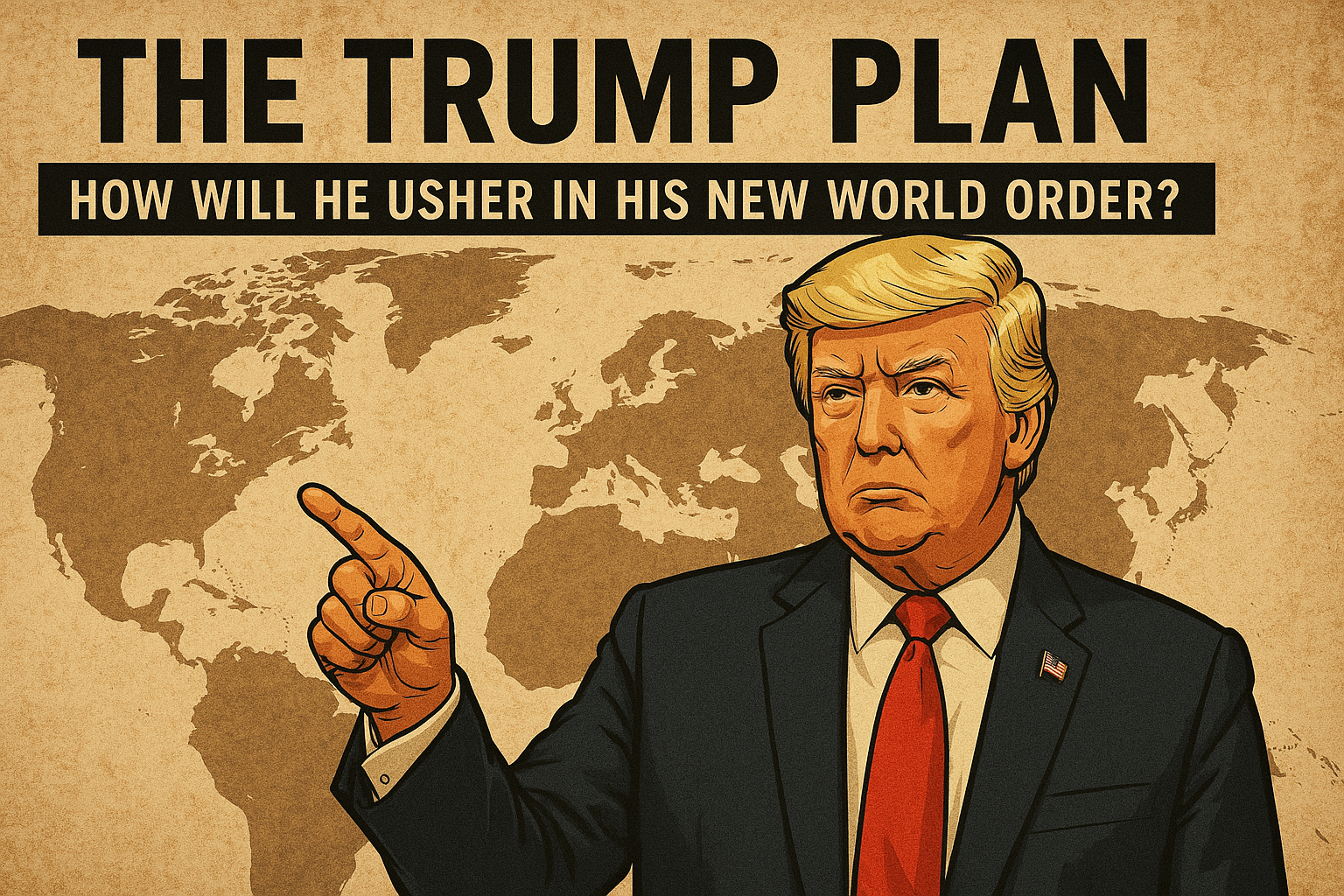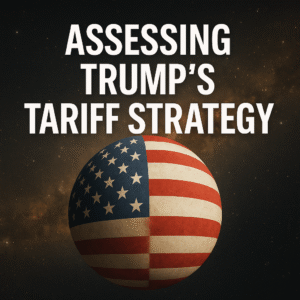Trump’s MAGA New World Order Plan
Trump’s “Make America Great Again†(MAGA) new world order plan can be pieced together from various sources in the public domain, including the Heritage Foundation’s Project 2025 strategy document, as well as publications and statements from key economic advisors to Trump, such as Stephen Miran. The plan can be broken down into the following steps:
- Imposition of tariffs
- Reform of the US tax system
- Energy and natural resource independence
- Development of domestic economic infrastructure
- Reform of the US financial system and restructuring of existing US debt
- Establishment of a new bilateral framework for international trade relations and world security architecture
1. Imposition of Tariffs
The rationale behind tariffs is relatively straightforward: to make it prohibitively expensive for transnational US companies to export to the US market. The US government effectively incentivises these companies to establish factories within the country, allowing them to bypass tariffs by manufacturing domestically.
Additionally, countries wishing to maintain low-tariff access to the US market will be pressured into negotiating with the US government. These negotiations will likely involve conditions such as strengthening their currency against the dollar, removing China from their supply chains, and respecting US intellectual property rights.
In essence, countries will be required to accept onerous US demands in exchange for market access. This marks a dramatic shift from the neoliberal free trade system that has underpinned global trade for the past 50 years. As a result, trade with the US will become more balanced, leading to a decline in dollar reserves among foreign nations and limiting their ability to trade globally or invest domestically. Tariff-based restrictions, particularly those targeting China, can be viewed as a form of economic warfare against US rivals—resulting in trade terms far worse than under the existing free trade regime.
2. Reform of the Tax System
Despite Trump’s assurances to the contrary, tariffs are almost certain to have a short-term inflationary impact—especially problematic given the immense financial pressure already on US consumers. A series of crises over the past decade—the 2008 financial crash, the COVID-19 pandemic, the Ukraine war, and the Gaza conflict—has exacerbated an ongoing cost-of-living crisis.
For Trump’s tariff plan to succeed, financial pressure on consumers must be alleviated to preserve or increase consumption levels. Proposed measures include the establishment of the Department of Government Efficiency (DOGE), aimed at reducing public expenditure and controlling the budget deficit.
Tax reform is also on the agenda. Senior Trump advisors have proposed replacing income tax with tariffs. In the short term, this would merely shift the tax burden. However, if tariffs successfully incentivise domestic manufacturing, the long-term goal is economic growth, increased real wages, and declining reliance on tariff revenue. Meanwhile, a weakened dollar would support a trade surplus, generating further revenue through indirect taxes.
All of these policies aim to reduce the tax burden on consumers, increase disposable income, and stimulate aggregate demand to drive growth.
3. Energy and Natural Resource Independence
Trump has famously championed the “drill, baby, drill!†slogan—emphasising his intention to significantly increase US oil production. But this ambition extends to all US natural resources. The United States is the second richest country globally in natural resources, valued at an estimated $45 trillion.
Since 1971, successive administrations have deliberately limited the exploitation of domestic resources—initially for geopolitical reasons, and more recently due to ideological commitments to climate change. For instance, US oil production declined from 9.5 million barrels per day (mbd) in 1970 to 5 mbd by 2008, even as consumption rose from 15 mbd to 20 mbd. Recent increases in production (to around 13 mbd) have been driven by strategic efforts toward energy independence.
Trump intends to reverse the 55-year trend of resource under-utilisation. Success in the MAGA project hinges on reducing industrial input costs while boosting real wages to fuel demand. This means lowering production costs through increased resource supply and technological efficiency.
This vision of economic self-sufficiency involves not just manufacturing, but also the extraction and processing of raw materials. The COVID-19 pandemic exposed critical supply chain vulnerabilities, with key industrial components sourced from distant, often adversarial nations. National security concerns underscore the urgency of reshoring supply chains.
Within this context, Trump’s rhetoric around annexing territories such as Canada, Greenland, and Panama reflects his intent to secure strategic resource bases. In a modern industrial economy, energy resources are not optional—they are fundamental.
4. Development of Domestic Economic Infrastructure
If the 19th century was defined by competition over agriculture, and the 20th by competition over energy, then the 21st may well be shaped by the race for rare earth minerals. As the world transitions to a fully automated, AI-driven economy, the demand for energy and computational power will skyrocket.
China currently controls 69% of rare earth production and 90% of processing. US dependency on China for critical materials used in semiconductor manufacturing is seen as a significant strategic vulnerability. Trump’s agenda includes securing alternative sources from Canada, Greenland, Latin America, and Ukraine.
Soon after his election, Trump announced a $500 billion investment into US digital infrastructure, including the Stargate initiative, aimed at ensuring continued technological leadership. This will be complemented by urban infrastructure renewal—reminiscent of FDR’s New Deal in the 1930s. Unlike Obama’s Green New Deal, which emphasised clean energy, Trump’s strategy prioritises traditional energy and industrial revitalisation.
5. Financial Reform and Debt Restructuring
Trump’s ambitious programme will require vast financial resources. However, with $100 trillion in debt and an additional $100–150 trillion in unfunded liabilities, the US faces a major funding challenge.
The US model of credit-fuelled consumption has eroded the industrial base and driven speculative finance. Interest payments on debt now exceed military spending—an ominous milestone historically associated with imperial decline.
Reversing this decline means addressing the debt burden through radical financial reform. Project 2025 proposes abolishing the Federal Reserve and placing monetary policy directly under government control. This would allow for debt restructuring, especially the $27 trillion owed to foreign creditors.
There is also discussion of returning to a gold-backed monetary system. Since Trump’s inauguration, gold has flowed into the US from major bullion hubs such as London and Switzerland—suggesting preparations for a financial system reset to facilitate industrial repatriation.
6. New Framework for Trade and Security
The ultimate goal of these reforms is to bolster US global power. While the US has vast natural resources, it will still require foreign materials to fuel its industrial machine. This necessitates new trade and political frameworks.
Post-WWII multilateral institutions—the UN, IMF, World Bank, and WTO—were designed to give the impression of global democracy. In reality, they have served to advance Western, particularly liberal elite, interests. Initiatives like the UN’s Agenda 2030, which promotes degrowth and deindustrialisation, reflect this ideological bias.
Multilateralism has often constrained US national interests. Trump plans to replace it with bilateralism—enabling the US to negotiate favourable terms with individual nations. He has already threatened to defund the IMF and World Bank and pressured NATO allies to contribute more to collective defence.
Trump’s vision is for countries under the US security umbrella to effectively pay for protection. One proposal under consideration involves converting foreign-held 10-year US Treasuries into non-tradeable 100-year bonds—ordinarily a default, but offset with security guarantees. This would integrate military and trade deals into a single strategic framework.
Another idea is the creation of an exclusive “US Dollar Zone,†where member countries trade in dollars and receive security in return. This would function as a modern-day tribute system, reinforcing US dominance.
Conclusion
Trump’s strategy is seismic—ushering in changes typically seen once in a century. The primacy of the US dollar still places America at the centre of global trade, despite its declining manufacturing base. Trump is leveraging this position while he still can. The tariff war is a calculated move to destabilise the existing global economy in pursuit of a US resurgence in manufacturing, innovation, and finance.
Had the US waited another decade, the BRICS alliance may well have displaced it from the centre of global trade. Trump’s gambit may be risky, but from his perspective, it’s a necessary last chance to reverse America’s decline.
The Centre for Muslim Political Analysis, Strategy, and Solutions (COMPASS) is a think tank focused on developing long-term thinking, strategy, and policy to support the progress of the Muslim world.



